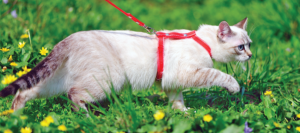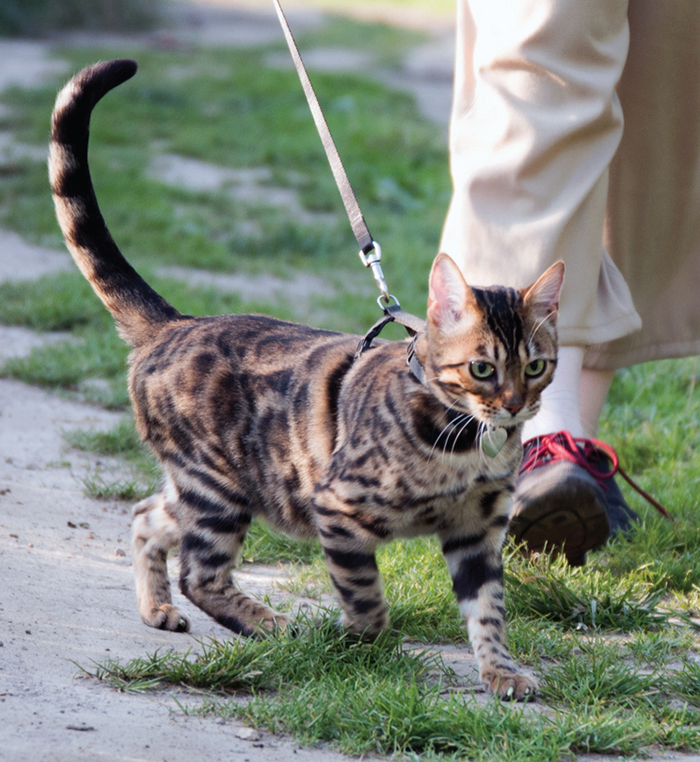Many of our feline friends are fascinated with the great outdoors, but letting cats roam freely comes with a myriad of problems and risks. Outdoor cats are at a higher risk of getting injured in fights or attacks from other animals, more likely to get hit by a car, at higher risk for contracting diseases such as feline leukemia and rabies, more likely to produce unplanned litters, a threat to native birds and small mammal species, and more likely to be targeted by angry neighbors for soiling lawns or scratching outdoor furniture.
Thankfully, it is possible to give your kitty outdoor time while keeping her and wildlife safe. One solution is to build a “catio,” a fully enclosed outdoor space where she can enjoy the breeze and lounge in the sun. The other is to teach her to walk on a leash so she can go for strolls with you.
“It is easy to train your cat to walk on a leash,” says Leni K. Kaplan, DVM, MS, senior lecturer in Cornell’s Community Practice Service. “The trick is to be patient, go slow, and use a lot of positive reinforcement (yummy treats, fun toys).”
Getting Started
Start by choosing a harness that you like and that fits your cat well. Dr. Kaplan says, “Select a harness that is properly fitted to the cat and not loose (you do not want the cat to slip out of it on a walk). Put the harness on and take it off immediately, then give the cat a treat. Do this over time and leave the harness on for longer and longer periods until the cat seems comfortable. The cat should be so comfortable in the harness that it is willing to sleep, eat, and wear the harness in the house when not on walks.”
The next step is to introduce the leash and the concept of not being able to go wherever the cat wants. “Attach the leash and let them drag it around the house so they get used to the weight of the leash,” says Dr. Kaplan. “Feed them treats or give them a favorite toy while they are getting used to being tethered. Practice walking with them in the house and make sure they are comfortable with it.”
Some cats may be uncertain about you walking close by at first. Use treats or a toy to get your cat to follow you, or you can follow your cat and let her choose where you go. Practice for a few minutes at a time, gradually increasing the sessions as she becomes more relaxed and gets used to the routine.

Why A Harness?
Harnesses are the best choice for leash walking a cat for several reasons. First, many cat collars are breakaway, meaning that even mild pressure will cause them to unbuckle and release your cat. Second, cats are flexible and can often wriggle out of a collar unless it is extremely tight. Cats can wiggle out of harnesses too, but the extra straps provide added security. Third, cats have more delicate throats than dogs, so pulling on your cat’s neck with a leash could result in injury or irritation to her trachea. Just be sure the harness you choose does not interfere with your cat’s shoulder movement (see October 2020 issue for more on choosing harnesses).
Moving Outdoors
“When you first go outdoors, do so for shorter periods of time until they are comfortable being outdoors and wearing a harness while leashed,” says Dr. Kaplan. If your cat has been outside before, she will acclimate more quickly, but being out while on a leash and harness may make her feel vulnerable at first because she is restricted in where she can go. She will quickly figure out that many of the predators and threats that loom large for a cat on her own stay away from a cat accompanied by her human.
For cats that have always been indoor cats, the great outdoors can be overwhelming at first. Hold on tightly to her leash but expect that she may just hunker down next to the porch or your leg for the first few outings. Keep these “walks” short and be patient. In the meantime, you can keep working on leash walking indoors where she is comfortable.
When your cat starts to relax while outside, let her choose where you walk together, trying to keep pressure off the leash. Do this for several outings until your cat is enjoying her walks. Some cats can be trained to follow you even outside, while others may be more independent and prefer to choose their own adventure.
Veterinary Office Visits
“My preference for the cat’s safety is to use a carrier,” says Dr. Kaplan. “This way, they cannot escape and other animals cannot access the cat and possibly cause injury.” If your cat becomes frightened in the lobby or parking lot, she could also potentially scratch or bite you or a staff member.
Dr. Kaplan says, “If a cat is absolutely terrified of the carrier or becomes super anxious in a carrier, then the less stressful solution is the leash. My biggest recommendation is to train the cat to the carrier, so it likes being in the carrier as well as eating and sleeping in the carrier . . . slowly work with the kitty to get comfortable in the carrier—do it on the cat’s timeline.”




